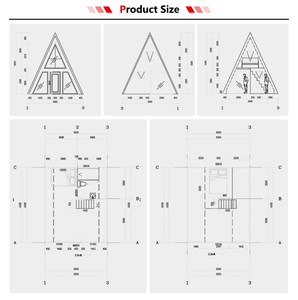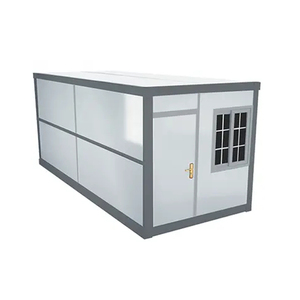(147849 products available)











































































































































































































Low-cost homes are houses built for less money than usual. They can be built quickly, and their construction uses affordable materials. They are also called affordable housing or budget homes.
Low-cost homes are houses that families can buy or rent for a reasonable price. They are not as expensive as traditional homes. Buying or renting a low-cost home is good for people with average or below-average incomes.
Low-cost homes come in different types and designs. They include:
Container homes
Container homes are houses built using shipping containers. Shipping containers are used to transport goods over long distances. These homes are cost-effective because shipping containers are relatively cheap. They are also durable and easy to find. Container homes are also quick to build and can be easily moved from one place to another.
Mobile homes
Mobile homes, also known as manufactured homes, are houses built in factories and then moved to a specific location. They are cost-effective because they are built quickly and with less labor. Mobile homes are also affordable and offer good value for the money.
Prefabricated homes
Prefab homes are houses constructed using prefabricated parts. These homes are cost-effective because they are built in a factory and assembled on-site. This process reduces labor costs and construction time. Prefabricated homes are also efficient and have a higher level of quality due to factory precision.
Tiny homes
Tiny homes are exactly what they sound like. They are small houses. These homes are small but still provide all the necessities. Because these homes are small, they require less money to build. They are also cheap to maintain. Additionally, they offer the freedom to move around.
Wood frame homes
These homes are built using a wooden frame. Wood is an inexpensive building material compared to steel or concrete. Building a wooden frame house is also cheaper because wood is readily available. Additionally, these homes are warm and cozy.
Earthbag homes
Earthbag homes are exactly what they sound like. They are houses made from bags filled with earth. These homes are cost-effective because they use cheap materials, such as bags and earth. Earth is usually available for free. These homes can be built by anyone because the process is simple and does not require special skills.
Below are some of the features and functions of low-cost homes.
Affordable Housing Initiatives
Container houses can be used to create low cost homes in areas where housing is needed. For example, container houses can be set up as projects that give houses at prices that more people can afford. This helps people who would otherwise have trouble finding a house within their budget. Projects like these allow low cost homes to be built quickly and for less money. Many people can then buy them or rent them for an amount that works with their finances.
Emergency and Temporary Housing
Mobile homes are often used as emergency and temporary housing. These homes can be set up quickly after natural disasters or other emergencies happen. This gives people a safe place to stay while repairs are made or other housing is found. Mobile homes are also used in areas with lots of people but not enough houses. They provide temporary shelter until more permanent housing options are available.
Workforce Housing
Low cost homes can be used as workforce housing. This means these homes are affordable for people who work in a community but may not make enough money to pay the higher prices for houses there. Examples include teachers, healthcare workers and first responders. When these homes are available, more essential workers can live in the areas they serve.
Modular and Prefabricated Homes
Homes that are modular or prefabricated offer an efficient way to build low cost homes. Since the construction is done off-site in a factory, it can be done more quickly and with fewer materials wasted. Once the homes are made, they are transported to the site and put together. This process saves time and money, allowing homes to be sold or rented at lower prices. Without sacrificing quality, these homes appeal to a broad range of buyers.
Co-housing and Shared Living Arrangements
Low cost homes can also accommodate co-housing and shared living situations. These involve people sharing a house or living space together, which reduces individual housing costs. Groups of friends, families, or individuals with similar goals can pool their resources to buy or rent a larger home together. By splitting the expenses, each person's financial burden is lighter. This is especially useful in high-cost areas where individual units may be unaffordable.
Cost
When selecting homes that are low cost, it is important to look at the cost of construction. Some homes are more expensive to build than others, and this affects the overall cost. For example, traditional homes made of bricks and mortar are often very expensive to build. On the other hand, container houses and prefabricated homes can be built at a lower cost. Cost comparison is necessary to determine which homes can be built at a lower price, depending on the market conditions.
Durability and Weather Conditions
Another factor to consider is how long the homes will last and the different weather conditions. It is important to look at how long the homes will last and whether the weather conditions are harsh, such as strong winds, heavy rain, or extreme temperatures. Some homes can withstand tough weather conditions better than others. For example, traditional homes are very strong and can handle any weather. However, low-cost homes, such as container houses, may not be as strong in harsh weather conditions.
Mobility
Mobility is also important when choosing a low-cost home. Some homes, like traditional houses, are not mobile because they are built permanently on one site. However, other homes, such as container houses and prefab homes, are mobile and can be moved easily from one place to another.
Materials used
The materials used to build the house affect both the cost and the look of the house. Different materials give the house different finishes and styles that appeal to different people.
Target market
The target market also affects which low-cost homes are popular. Different people want different things in a home, and some homes suit certain groups better than others. For example, first-time buyers, families, and retirees all have different needs and budgets when it comes to buying a home.
Location
The location where the home will be built affects the kind of homes that can be built. Some locations have rules about building homes, and other locations have different types of homes that people want. People living in cities want different homes than people living in the countryside.
Q1: What are the advantages of building a low cost home?
A1: There are many advantages, including minimal environmental impact, improved affordability, and faster construction time. Low-cost homes are also often built using innovative building techniques and materials, which can provide a unique and modern aesthetic.
Q2: What features should a low-cost home have?
A2: Low-cost homes should have energy-efficient features, a well-thought-out design, and durable materials. Essential features include an open floor plan, strategically placed windows for natural light, and a functional kitchen and bathroom.
Q3: What are some challenges when building low-cost homes?
A3: Challenges include sourcing affordable yet quality materials, skilled labor availability, and meeting regulatory requirements. It can also be challenging to balance cost-cutting measures without compromising the home's quality and integrity.
Q4: How can one ensure the low-cost home is durable?
A4: To ensure durability, use quality construction materials, employ skilled labor, and adopt proper building techniques. It is also important to have a well-planned construction process and regular monitoring to ensure everything is done correctly.
Q5: Are low-cost homes a good investment?
A5: Yes, low-cost homes can be a good investment. They offer affordability, which appeals to many buyers. Additionally, if properly located and constructed, they can generate good returns. Also, investing in low-cost rental properties is a great way to achieve financial freedom.
The keyword "low cost homes" has experienced significant fluctuations in web search volume over the past year, with an average monthly web search volume of 170. Despite showing no change over the last three months, the one-year change reflects a substantial increase of 91%. This indicates a growing interest in affordable housing solutions, particularly noticeable in the last quarter of the year.
Analyzing the monthly search data reveals a pattern of increasing interest in low-cost homes. Starting from December 2023 with 110 web searches, the volume gradually increased, reaching a plateau of 140 web searches from January to May 2024. However, a notable spike occurred from June 2024, escalating to 210 web searches by August and maintaining this peak through to November. This trend suggests a seasonal influence, potentially linked to housing market trends or specific events that stimulate interest in affordable housing solutions during these months.
The data highlights the cyclical nature of search interest in "low cost homes," with peaks typically occurring during specific times of the year. This could be influenced by various factors such as economic conditions, housing market trends, or even public policy announcements that encourage or highlight the need for affordable housing solutions. Understanding these patterns helps in predicting future demands and planning appropriate marketing or public information campaigns to address the needs of potential home buyers seeking affordable options.